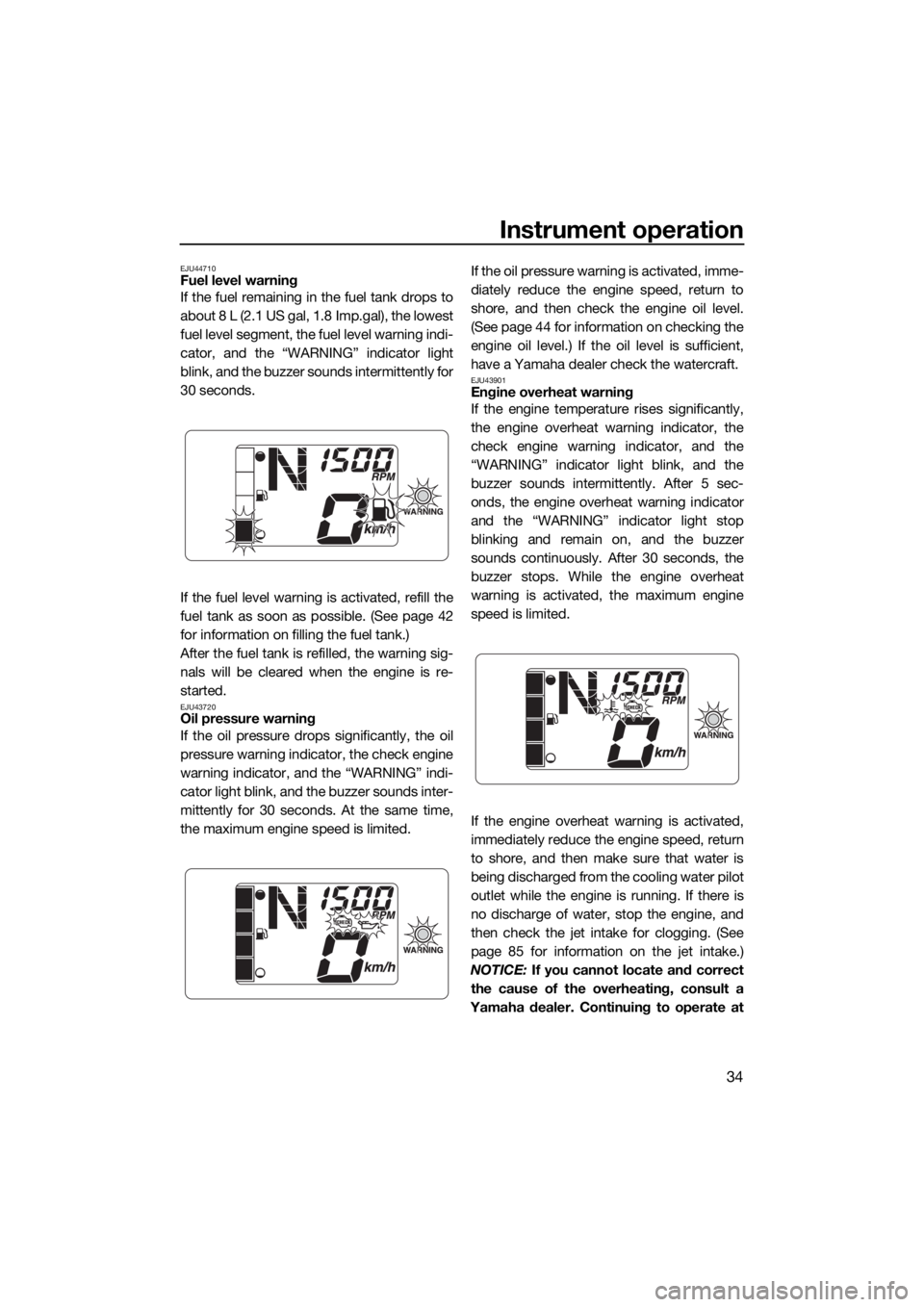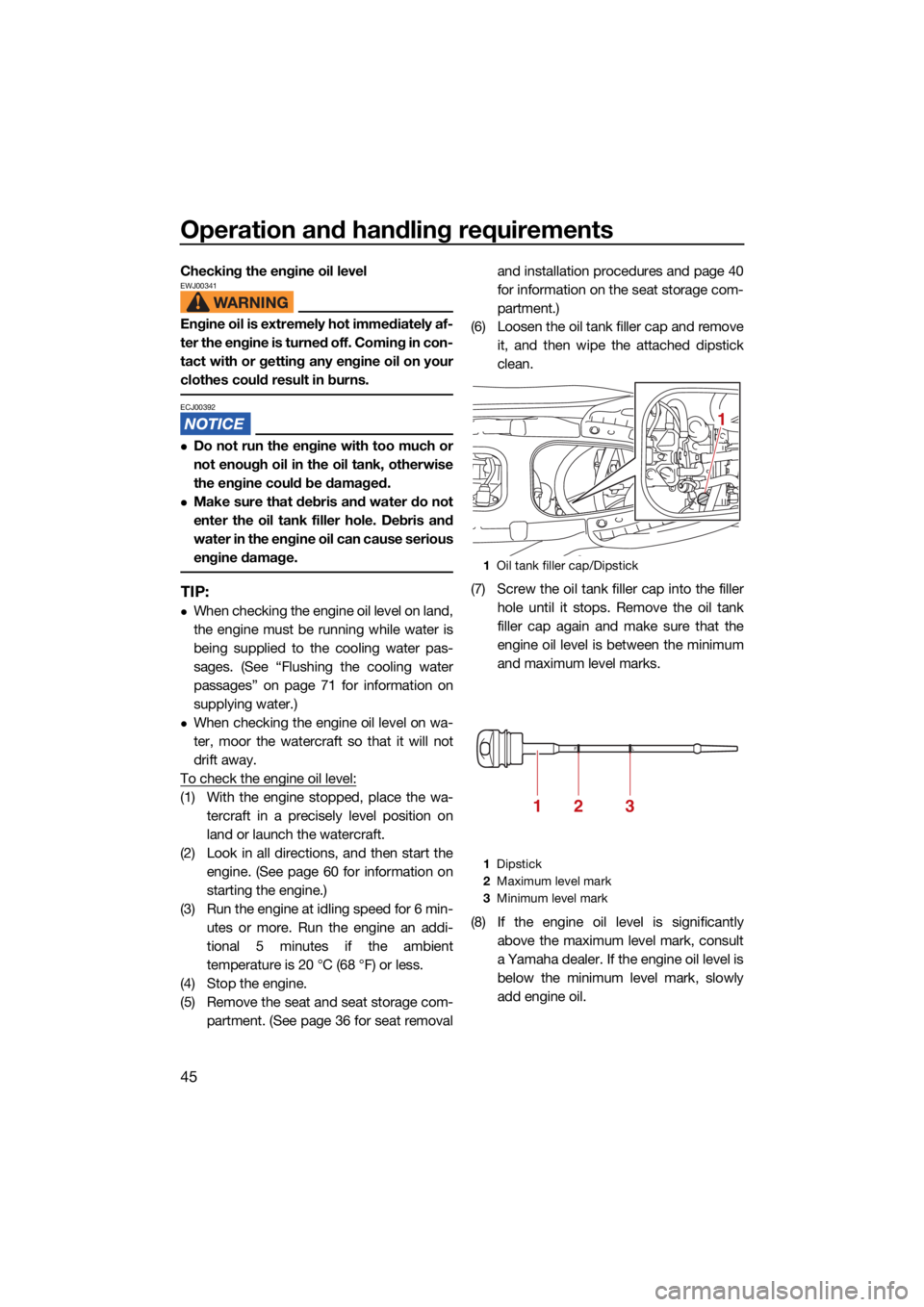cooling YAMAHA EXR 2021 Owners Manual
[x] Cancel search | Manufacturer: YAMAHA, Model Year: 2021, Model line: EXR, Model: YAMAHA EXR 2021Pages: 98, PDF Size: 4.56 MB
Page 6 of 98

Table of contents
General and important labels ........... 1Identification numbers .................... 1
Primary Identification (PRI-ID)
number............................................ 1
Craft Identification Number (CIN) ....... 1
Engine serial number.......................... 1
Manufactured date label .................... 2
Model information ........................... 2
Builder’s plate .................................... 2
Important labels .............................. 4
Warning labels.................................... 5
Other labels ........................................ 8
Safety information ............................. 9 Limitations on who may operate the watercraft ............................... 9
Cruising limitations ........................ 10
Operation requirements ................ 11
Recommended equipment ........... 13
Hazard information........................ 14
Watercraft characteristics ............. 14
Wakeboarding and water-skiing ... 16
Safe boating rules ......................... 17
Enjoy your watercraft responsibly ................................. 18
Description....................................... 19 Watercraft glossary ....................... 19
Location of main components ...... 20
Control function operation ............. 24 Watercraft control functions ......... 24
Engine stop switch .......................... 24
Engine shut-off switch .................... 24
Start switch ..................................... 24
Throttle lever .................................... 25
RiDE lever ........................................ 25
Steering system ............................... 25
Cooling water pilot outlet ................. 26
Water separator................................ 26
Watercraft operation ...................... 28Watercraft operation functions ..... 28
Shift system ..................................... 28
Instrument operation ...................... 31Multifunction information center ... 31
Information display ........................... 31
Equipment operation ...................... 36Equipment..................................... 36
Seat .................................................. 36
Handgrip........................................... 36
Reboarding grip................................ 37
Reboarding step ............................... 37
Bow eye............................................ 38
Stern eyes ........................................ 38
Cleat ................................................. 38
Storage compartments .................... 38
Fire extinguisher holder .................... 41
Operation and handling
requirements ................................... 42Fuel requirements ......................... 42
Fuel................................................... 42
Engine oil requirements ................ 44
Engine oil .......................................... 44
Draining the bilge water ................ 46
Draining the bilge water on land....... 46
Draining the bilge water on water .... 47
Transporting on a trailer................ 48
First-time operation ........................ 49 Engine break-in............................. 49
Pre-operation checks ..................... 50
Pre-operation checklist .................... 50
Pre-operation check points .......... 52
Pre-launch checks ........................... 52
Post-launch checks.......................... 57
Operation ......................................... 59 Operating your watercraft ............. 59
Getting to know your watercraft....... 59
UF4L72E0.book Page 1 Thursday, June 18, 2020 1:29 PM
Page 7 of 98

Table of contents
Learning to operate your watercraft ...................................... 59
Riding position ................................. 60
Launching the watercraft ................. 60
Starting the engine on water ............ 60
Stopping the engine ......................... 61
Leaving the watercraft...................... 61
Operating the watercraft .................. 61
Turning the watercraft ...................... 62
Stopping the watercraft ................... 63
Operating the watercraft in reverse or neutral ...................................... 64
Boarding the watercraft ................... 65
Starting off........................................ 67
Capsized watercraft ......................... 68
Beaching and docking the watercraft ...................................... 69
Operating in weeded areas .............. 69
After removing the watercraft from the water ....................................... 70
Care and storage............................. 71Post-operation care ...................... 71
Flushing the cooling water
passages....................................... 71
Cleaning the watercraft .................... 72
Battery care ...................................... 72
Long-term storage ........................ 74
Cleaning ........................................... 74
Lubrication ....................................... 74
Rustproofing..................................... 75
Maintenance .................................... 77 Maintenance.................................. 77
Periodic maintenance chart ............. 78
Engine oil and oil filter ...................... 80
Specifications .................................. 81Specifications................................ 81
Trouble recovery ............................. 82 Troubleshooting ............................ 82
Troubleshooting chart ...................... 82
Emergency procedures ................ 85
Cleaning the jet intake and
impeller ......................................... 85
Raising the reverse gate .................. 86
Jumping the battery ......................... 86
Towing the watercraft....................... 87
Submerged watercraft ..................... 87
Index................................................. 89
UF4L72E0.book Page 2 Thursday, June 18, 2020 1:29 PM
Page 27 of 98

Description
20
EJU31012
Location of main components
Exterior
124
78
3
63
1211109
5
1Hood
2 Handlebar
3 Footwell
4 Seat (page 36)
5 Boarding platform
6 Fuel filler cap (page 42)
7 Handgrip (page 36)
8 Reboarding grip (page 37) 9
Sponson
10 Gunwale
11 Cooling water pilot outlet (page 26)
12 Bow eye (page 38)
UF4L72E0.book Page 20 Thursday, June 18, 2020 1:29 PM
Page 33 of 98

Control function operation
26
zle is changed, and the direction of the water-
craft is changed accordingly.
Since the strength of the jet thrust determines
the speed and degree of a turn, throttle must
always be applied when attempting a turn,
except at trolling speed.
This model is equipped with the Yamaha En-
gine Management System (YEMS) that in-
cludes an off-throttle steering (OTS) system.
It will activate at planing speeds should you
attempt to steer the watercraft after releasing
the throttle lever. The OTS system assists in
turning by continuing to supply some thrust
while the watercraft is decelerating, but you
can turn more sharply if you apply throttle
while turning the handlebars. The OTS sys-
tem does not function below planing speeds
or when the engine is off. Once the engine
slows down, the watercraft will no longer turn
in response to handlebar input until you apply
throttle again or you reach trolling speed.EJU35975Cooling water pilot outlet
When the engine is running, some of the
cooling water that is circulated in the engine
is discharged from the cooling water pilot
outlet.
There is a cooling water pilot outlet on the
port (left) side of the watercraft. To check for
proper operation of the cooling system, make
sure that water is being discharged from the
cooling water pilot outlet. If water is not being
discharged from the outlet, stop the engine
and check the jet intake for clogging. (See
page 85 for information on the jet intake.)
TIP:
It will take about 60 seconds for the water
to reach the outlet after the engine is start-
ed.
Water discharge may not be constant
when the engine is running at idling speed.
If this occurs, apply a little throttle to make
sure that water discharges properly.
EJU40323Water separator
The water separator prevents water from en-
tering the fuel tank by collecting any water
that has entered the fuel tank breather hose if
the watercraft was capsized.
1Handlebar
2 Jet thrust nozzle
1
21Cooling water pilot outlet
1
UF4L72E0.book Page 26 Thursday, June 18, 2020 1:29 PM
Page 41 of 98

Instrument operation
34
EJU44710Fuel level warning
If the fuel remaining in the fuel tank drops to
about 8 L (2.1 US gal, 1.8 Imp.gal), the lowest
fuel level segment, the fuel level warning indi-
cator, and the “WARNING” indicator light
blink, and the buzzer sounds intermittently for
30 seconds.
If the fuel level warning is activated, refill the
fuel tank as soon as possible. (See page 42
for information on filling the fuel tank.)
After the fuel tank is refilled, the warning sig-
nals will be cleared when the engine is re-
started.
EJU43720Oil pressure warning
If the oil pressure drops significantly, the oil
pressure warning indicator, the check engine
warning indicator, and the “WARNING” indi-
cator light blink, and the buzzer sounds inter-
mittently for 30 seconds. At the same time,
the maximum engine speed is limited.If the oil pressure warning is activated, imme-
diately reduce the engine speed, return to
shore, and then check the engine oil level.
(See page 44 for information on checking the
engine oil level.) If the oil level is sufficient,
have a Yamaha dealer check the watercraft.
EJU43901Engine overheat warning
If the engine temperature rises significantly,
the engine overheat warning indicator, the
check engine warning indicator, and the
“WARNING” indicator light blink, and the
buzzer sounds intermittently. After 5 sec-
onds, the engine overheat warning indicator
and the “WARNING” indicator light stop
blinking and remain on, and the buzzer
sounds continuously. After 30 seconds, the
buzzer stops. While the engine overheat
warning is activated, the maximum engine
speed is limited.
If the engine overheat warning is activated,
immediately reduce the engine speed, return
to shore, and then make sure that water is
being discharged from the cooling water pilot
outlet while the engine is running. If there is
no discharge of water, stop the engine, and
then check the jet intake for clogging. (See
page 85 for information on the jet intake.)
NOTICE: If you cannot locate and correct
the cause of the overheating, consult a
Yamaha dealer. Continuing to operate at
UF4L72E0.book Page 34 Thursday, June 18, 2020 1:29 PM
Page 52 of 98

Operation and handling requirements
45
Checking the engine oil levelEWJ00341
Engine oil is extremely hot immediately af-
ter the engine is turned off. Coming in con-
tact with or getting any engine oil on your
clothes could result in burns.
ECJ00392
Do not run the engine with too much or
not enough oil in the oil tank, otherwise
the engine could be damaged.
Make sure that debris and water do not
enter the oil tank filler hole. Debris and
water in the engine oil can cause serious
engine damage.
TIP:
When checking the engine oil level on land,
the engine must be running while water is
being supplied to the cooling water pas-
sages. (See “Flushing the cooling water
passages” on page 71 for information on
supplying water.)
When checking the engine oil level on wa-
ter, moor the watercraft so that it will not
drift away.
To check the engine oil level:
(1) With the engine stopped, place the wa- tercraft in a precisely level position on
land or launch the watercraft.
(2) Look in all directions, and then start the engine. (See page 60 for information on
starting the engine.)
(3) Run the engine at idling speed for 6 min- utes or more. Run the engine an addi-
tional 5 minutes if the ambient
temperature is 20 °C (68 °F) or less.
(4) Stop the engine.
(5) Remove the seat and seat storage com- partment. (See page 36 for seat removal and installation procedures and page 40
for information on the seat storage com-
partment.)
(6) Loosen the oil tank filler cap and remove it, and then wipe the attached dipstick
clean.
(7) Screw the oil tank filler cap into the filler hole until it stops. Remove the oil tank
filler cap again and make sure that the
engine oil level is between the minimum
and maximum level marks.
(8) If the engine oil level is significantly above the maximum level mark, consult
a Yamaha dealer. If the engine oil level is
below the minimum level mark, slowly
add engine oil.
1Oil tank filler cap/Dipstick
1 Dipstick
2 Maximum level mark
3 Minimum level mark
1
213
UF4L72E0.book Page 45 Thursday, June 18, 2020 1:29 PM
Page 58 of 98

Pre-operation checks
51
TIP:
To ensure safety and reliability, pre-operation checks should be made each time the water-
craft is used.
POST-LAUNCH CHECKS
Cooling water pilot outlet Check that water is discharged from the cooling
water pilot outlet while the engine is running.
57
Multifunction information
center Check the multifunction information center for prop-
er operation.
57
Shift system Check the shift system for proper operation. 58
Engine idling speed Check the engine idling speed. 58
ITEM ROUTINE PAGE
UF4L72E0.book Page 51 Thursday, June 18, 2020 1:29 PM
Page 64 of 98
![YAMAHA EXR 2021 Owners Manual Pre-operation checks
57
flood the engine compartment and cause
the watercraft to submerge.
[ECJ00363]
Securely install the stern drain plugs by tight-
ening them until they stop.
EJU44640Hood check
C YAMAHA EXR 2021 Owners Manual Pre-operation checks
57
flood the engine compartment and cause
the watercraft to submerge.
[ECJ00363]
Securely install the stern drain plugs by tight-
ening them until they stop.
EJU44640Hood check
C](/img/51/49493/w960_49493-63.png)
Pre-operation checks
57
flood the engine compartment and cause
the watercraft to submerge.
[ECJ00363]
Securely install the stern drain plugs by tight-
ening them until they stop.
EJU44640Hood check
Close the hood, hook the hood latches, and
check that the hood is securely closed.
EJU40146Post-launch checks
Perform the post-launch checks in the pre-
operation checklist while the watercraft is in
the water and the engine is running.
To perform the post-launch checks:
(1) Launch the watercraft. (See page 60 forinformation on launching the watercraft.)
(2) Perform the checks and make sure that there are no malfunctioning items or oth-
er problems.
EJU40553Cooling water pilot outlet check
Make sure that water is discharged from the
cooling water pilot outlet while the engine is
running. (See page 26 for information on the
cooling water pilot outlet.)
EJU32715Multifunction information center check
Make sure that the multifunction information
center operates properly. (See page 31 for in-
formation on proper operation of the multi-
function information center.)
1Stern drain plug
2 O-ring
1 Stern drain plug
1 Hood latch
2
1
1
1
UF4L72E0.book Page 57 Thursday, June 18, 2020 1:29 PM
Page 77 of 98

Operation
70
EJU40242After removing the watercraft from
the water
ECJ01311
Do not run the engine over 4000 r/min on
land. Also, do not run the engine for more
than 15 seconds without supplying water,
otherwise the engine could overheat.
After operating and removing the watercraft
from the water, promptly discharge the re-
maining water from the cooling water pas-
sages.
To discharge water from the cooling water
passages:
(1) Make sure that the area around the wa- tercraft is clear, and then start the en-
gine.
(2) Discharge the remaining water out of the cooling water passages by alternately
squeezing and releasing the throttle lever
quickly for 10 to 15 seconds.
(3) Stop the engine.
UF4L72E0.book Page 70 Thursday, June 18, 2020 1:29 PM
Page 78 of 98

Care and storage
71
EJU37146
Post-operation careEWJ00331
Always place the watercraft upright in a
horizontal position when storing it, other-
wise fuel could leak out into the engine or
engine compartment, which could create
a fire hazard.
After using the watercraft, always take it out
of the water, clean it, and store it. Leaving the
watercraft in the water for extended periods
will accelerate the rate of normal deteriora-
tion of the jet pump and hull. Marine organ-
isms and corrosion are some of the
conditions that can shorten the life of many
watercraft components.
EJU44560Flushing the cooling water passagesECJ01311
Do not run the engine over 4000 r/min on
land. Also, do not run the engine for more
than 15 seconds without supplying water,
otherwise the engine could overheat.
Flush the cooling water passages to prevent
them from clogging with salt, sand, or dirt.
(1) Place the watercraft in a horizontal posi-tion.
(2) Remove the seat and seat storage com- partment. (See page 36 for seat removal
and installation procedures and page 40
for information on the seat storage com-
partment.) (3) Connect the garden hose adapter to a
garden hose.
(4) Loosen the flushing hose connector cap and remove it. Insert the garden hose
adapter into the flushing hose connector
by pushing and twisting it until it is se-
curely connected.
(5) Connect the garden hose to a water tap.
(6) Make sure that the area around the wa- tercraft is clear, and then start the en-
gine. Immediately after the engine starts,
fully turn the water supply on so that wa-
1Garden hose adapter
2 Garden hose
1 Flushing hose connector cap
2 Flushing hose connector
3 Garden hose adapter
12
32
1
UF4L72E0.book Page 71 Thursday, June 18, 2020 1:29 PM